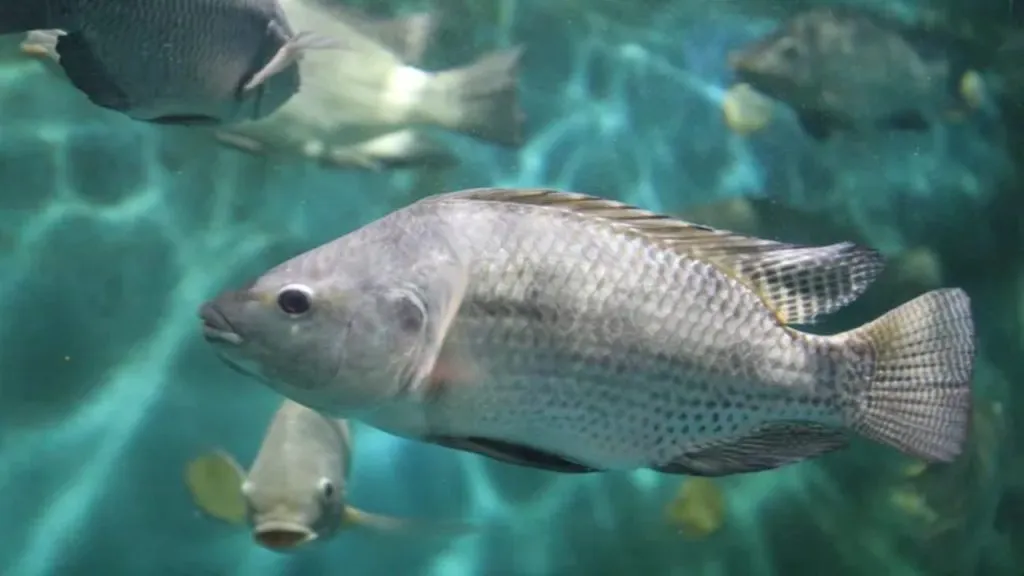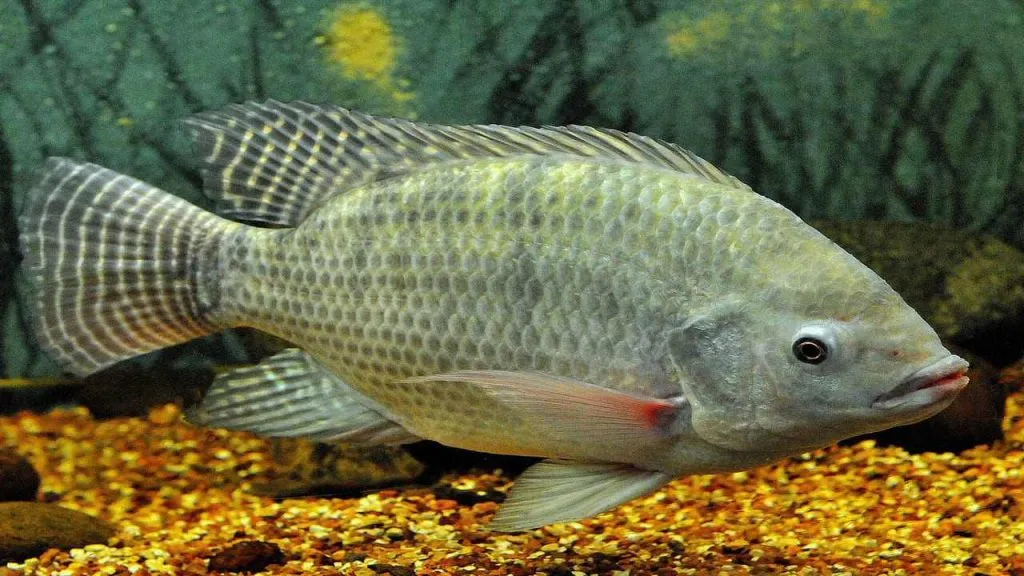As an Amazon Associate I earn from qualifying purchases.
Tilapia stands as a highly favored fish species enjoyed in many countries, ranking as the fourth most consumed fish in the United States.
Belonging to the cichlid order, over 100 species of fish are classified as tilapia.
These freshwater creatures typically inhabit shallow ponds, rivers, lakes, and dams.
Tilapia holds significant importance in agriculture, often bred for food due to its ease of care.
However, understanding the dietary preferences of tilapia is paramount not only for their growth and well-being but also for those involved in their cultivation or consumption.
In this blog post, we will discuss what food does tilapia fish eat.
And we will also explore what different types of tilapia eat when they live in the wild, on farms, or when people keep them as pets. So let’s get started!
What Does Tilapia Eat All Year-Round: The Complete List of Food

Tilapia, which are types of fish, eat a lot of different things depending on what’s available in their environment at different times of the year.
They mostly eat plants and small water creatures and also like to eat algae, which gives them important nutrients and energy.
They also eat different kinds of water plants, like ones that grow underwater or float on the surface.
Sometimes they eat small bugs such as mosquito larvae and flies, and tiny shrimp.
This helps them get enough protein and keeps their diet varied.
Tilapia also eat tiny floating animals called zooplankton, bits of dead plants and animals, and other decaying stuff in the water.
This helps keep the water clean and balanced. They also munch on worms, snails, and other small shellfish, and sometimes they eat other small fish.
It’s important for people who raise tilapia, like fish farmers, to understand what they like to eat so they can feed them well and make sure they stay healthy and grow properly all year round.
Now that we’ve figured out what tilapia usually eat, let’s take a closer look at what blue tilapia and Nile tilapia prefer to eat.
What Does Blue Tilapia Eat?
Blue tilapia are versatile eaters, consuming a mix of plants and animals both in their natural habitat and in aquaculture setups.
In the wild, they feast on algae, phytoplankton, zooplankton, small insects, and detritus, which refers to organic matter breaking down in water.
In aquaculture, blue tilapia primarily dine on commercial pelleted feed tailored to support their rapid and healthy growth.
These pellets are carefully crafted to furnish the necessary nutrients, typically comprising fish meal, soybean meal, and wheat flour, as well as essential vitamins and minerals.
Some farms might also enrich their diet with live foods like brine shrimp or worms to enhance their nutritional intake.
What Does Nile Tilapia Eat?
Nile tilapia stands out as a highly sought-after species for aquaculture, prized for its rapid growth, ability to thrive in diverse environments, and mild taste.
In their natural habitat, much like Blue Tilapia, Nile tilapia exhibit omnivorous tendencies, feasting on algae, phytoplankton, zooplankton, small invertebrates, and organic matter.
When raised on farms, Nile tilapia enjoy a diet akin to their farmed counterparts, typically consisting of commercial pellets specially formulated with a blend of plant-derived and animal-derived components.
These pellets are carefully crafted to meet the nutritional needs of Nile tilapia, ensuring optimal health and growth in aquaculture settings.
What Do Baby Tilapia Eat
Baby tilapia, also known as fry, have distinct dietary requirements based on their growth stage.
Initially, they rely on their yolk sacs for nutrition as they do not have mouths yet.
In the wild, they depend on natural organisms like zooplankton, insect larvae, tiny crustaceans, and microscopic algae for sustenance, gradually transitioning to an omnivorous diet similar to adult tilapia as they mature.
Additionally, they may consume small plant matter and detritus found in their habitat.
In farms, baby tilapia are fed commercially formulated diets rich in proteins such as fish meal and soybean meal, supplemented with vitamins and minerals to support rapid growth and health.
They may start with powdered or finely ground feeds before advancing to larger pellets.
Regardless of their environment, maintaining water quality is crucial for the health and feeding habits of baby tilapia, ensuring their proper growth and survival.
What Do Pet Tilapia Eat: What Do Feed Them
Pet tilapia, just like their wild relatives, have specific food needs that keep them healthy and happy.
Even though not many people keep tilapia as pets compared to other fish, those who do might wonder what to feed them.
Pet tilapia really like to eat commercial fish pellets or flakes that are made for fish like them, which you can find in pet stores.
These pellets usually have a mix of plant and animal stuff that gives them all the good things they need like protein, vitamins, and minerals.
It’s a good idea to choose pellets from good brands and avoid ones with things like cornmeal added.
Sometimes, pet tilapia enjoy little treats like pieces of apple, mango, or vegetables like peas, spinach, zucchini, lettuce, or cucumber.
But it’s important not to give them too much of these leafy greens because it can make the water dirty.
Sometimes, they might get special treats like brine shrimp or bloodworms, but it’s important not to give them too much to keep the water clean.
It’s also essential to watch how much you feed them and clean up any leftover food to keep the water clean and their health good.
The pellets are good because they have all the right things in them and don’t bring in any bugs.
When tilapia are babies, they need to eat more often, maybe 5-7 times a day, but as they grow up, they don’t need to eat as much.
Live food like brine shrimp should be cleaned before giving it to them to keep them safe.
Remember, keeping their home clean with regular water changes and filters is really important for keeping pet tilapia happy and healthy.
Aside from knowing what food pet tilapia enjoy, it’s interesting to see how they find and catch their meals in the wild.
How Do Tilapia Find Its Food: The Hunting Method of Tilapia

Tilapia have a special way of finding their food in the water, even though it’s not quite like how land animals hunt.
Instead, they use their senses and behaviors to search for food.
Tilapia mostly rely on their sense of smell and sight to find potential food in their surroundings.
They can sense chemicals and movements in the water, which helps them locate food particles and organisms.
When they find food, tilapia use their mouths to look through the water and the stuff at the bottom, trying to find things to eat.
They eat both plants and animals, which means they have a wide range of foods to choose from like algae, aquatic plants, small bugs, and tiny particles of waste.
Tilapia are also pretty smart about finding food.
They take advantage of any food they find, moving around their habitat to search for more.
They look at different parts of the water, like on the surface or at the bottom, and among plants.
In summary, tilapia find their food by using their senses and searching around their environment.
They eat lots of different things, and they’re always on the lookout for more food to eat.
Conclusion
In summary, knowing what tilapia like to eat is important for keeping them healthy, whether they’re in their natural habitats or in tanks or ponds.
Tilapia are pretty flexible with what they eat, whether they’re in the wild, on farms, or kept as pets.
Their ability to eat a variety of foods is one reason why they’re so well-liked.
By giving them the right kind of food, we can make sure that these freshwater fish stay strong and lively.
FAQ’s:
Tilapia typically eat around 1-3% of their body weight daily.
This amount can vary based on factors like the size of the fish, water temperature, and the availability of food in their environment.
The lifespan of a tilapia fish can vary depending on factors such as species, environmental conditions, and care.
Generally, tilapia in the wild can live for about 5-7 years, while those raised in aquaculture settings may have shorter lifespans due to accelerated growth and harvesting.
Tilapia are not typically aggressive towards other fish and are generally considered peaceful.
However, under certain conditions such as overcrowding or limited food supply, tilapia may exhibit territorial behavior and compete with other fish for resources.
In rare cases, larger tilapia may prey on smaller fish if they are hungry or stressed.
Tilapia are not known to eat their eggs intentionally.
In fact, they exhibit parental care behaviours by guarding and protecting their eggs until they hatch.
However, environmental stressors or disturbances in the habitat may lead to unintentional egg consumption by tilapia or other fish species present in the same environment.
Amazon and the Amazon logo are trademarks of Amazon.com, Inc, or its affiliates.

